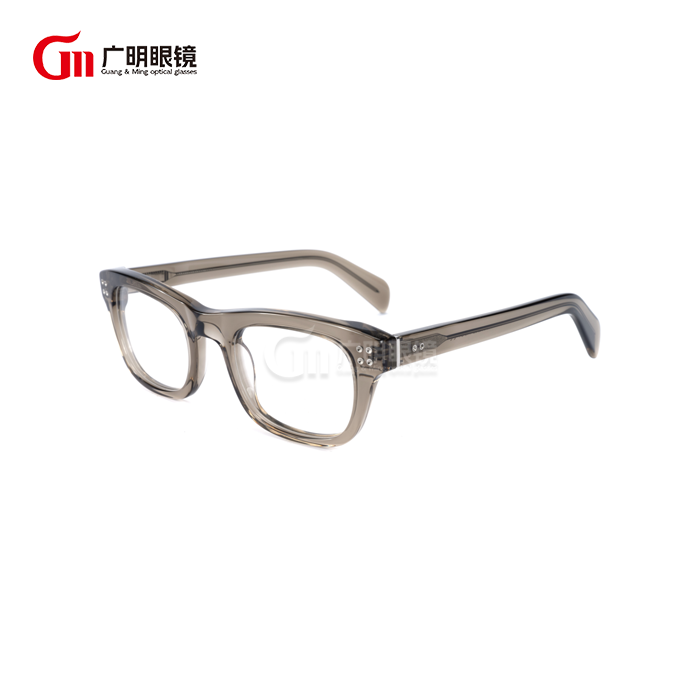What Makes Acetate Optical Frames Special?
Acetate optical frames represent one of the most popular choices in eyewear today, known for their durability, versatility, and aesthetic appeal. These frames are crafted from a specific type of plastic called cellulose acetate, which offers unique properties that make it ideal for eyeglasses. Unlike standard plastic frames, acetate optical frames provide superior comfort, flexibility, and a distinctive high-quality appearance that appeals to fashion-conscious consumers and practical wearers alike. The material's versatility allows for an incredible range of colors, patterns, and finishes that cannot be achieved with other frame materials.
What makes acetate optical frames different from other eyewear materials?
Superior Composition and Manufacturing Process
Acetate optical frames stand apart from other eyewear materials primarily due to their composition and manufacturing process. Unlike injection-molded plastic frames, acetate optical frames are made from cellulose acetate, a plant-based plastic derived from cotton fibers and wood pulp. This natural origin gives acetate optical frames hypoallergenic properties, making them suitable for people with sensitive skin or metal allergies. The manufacturing process involves creating large blocks or sheets of acetate that are then cut, shaped, tumbled, and polished by skilled craftsmen. This labor-intensive process results in frames with richer colors, better transparency, and a more luxurious feel compared to standard plastic frames. Additionally, acetate optical frames maintain their shape and color for years, resisting fading and becoming brittle over time, unlike their cheaper counterparts.
Aesthetic Versatility and Customization Options
One of the most significant advantages of acetate optical frames lies in their unmatched aesthetic versatility. The material can be layered, mixed, and manipulated to create an infinite variety of patterns, colors, and textures. From classic tortoiseshell to vibrant multi-colored designs, acetate optical frames offer endless possibilities for personalization. Manufacturers can embed different colors and patterns throughout the material, rather than just applying color to the surface, resulting in depth and dimension that cannot be achieved with other materials. This quality allows acetate optical frames to feature unique marbling effects, gradient colors, and even custom-made patterns. When frames are cut and polished, each piece reveals its own distinctive pattern, making every pair of acetate optical frames somewhat unique. This level of customization makes acetate the preferred material for designer and luxury eyewear brands.
Comfort and Wearability Factors
Acetate optical frames excel in providing superior comfort for everyday wear. The material has a lightweight nature compared to materials like metal or some other plastics, reducing pressure on the nose bridge and ears during extended wear. Additionally, acetate optical frames possess natural flexibility, allowing them to be adjusted for a perfect fit without compromising their structural integrity. This material also maintains a comfortable temperature against the skin, neither becoming too cold in winter nor too hot in summer, unlike metal frames. Acetate optical frames can be precisely adjusted by heating the material gently, enabling opticians to customize the fit for each wearer's face shape and comfort needs. The hypoallergenic nature of acetate also means these frames rarely cause skin irritation or allergic reactions, making them suitable for those with sensitive skin conditions.
How are high-quality acetate optical frames manufactured?
Raw Material Selection and Preparation
The journey of high-quality acetate optical frames begins with careful selection of raw materials. Premium cellulose acetate starts with cotton linters and wood pulp that undergo chemical processing with acetic acid and other compounds to create cellulose acetate flakes. For superior acetate optical frames, manufacturers source their acetate from renowned producers like Mazzucchelli 1849 in Italy or Takiron in Japan, known for their exceptional quality standards. These raw materials are mixed with carefully selected dyes and stabilizers to create the desired colors and patterns. The acetate is then formed into large blocks or sheets through processes that involve heat and pressure. During this stage, different colored acetate layers can be combined to create unique patterns like tortoiseshell or multicolored designs. The quality of these initial materials and the precision of this preparation phase directly influence the final appearance, durability, and comfort of acetate optical frames.
Cutting, Shaping, and Polishing Techniques
Once the acetate sheets or blocks are prepared, the manufacturing of acetate optical frames enters the most skill-intensive phase. Skilled technicians either use CNC machines for precision cutting or traditional methods involving die-cutting to create the basic frame shapes from acetate sheets. For premium acetate optical frames, manufacturers often opt for cutting from blocks rather than sheets to achieve better strength and dimensional stability. After cutting, the rough frame shapes undergo multiple stages of refinement through tumbling processes with increasingly fine materials. This tumbling smooths edges and begins to bring out the luster of the material. Next, skilled craftspeople hand-polish acetate optical frames to achieve the characteristic shine and smooth texture associated with high-quality eyewear. During this stage, the frames also undergo precise drilling for hinge attachment and lens fitting. Throughout these processes, acetate optical frames require careful handling to prevent warping or damage to the material.
Final Assembly and Quality Control
The final stages in manufacturing high-quality acetate optical frames involve assembly and rigorous quality control. Metal components such as hinges, screws, and core wires are carefully integrated into the acetate structure. For premium acetate optical frames, manufacturers often use five or seven-barrel hinges rather than standard three-barrel ones, providing greater durability and smoother movement. The assembled frames then undergo final polishing to remove any marks from the assembly process. Quality control specialists inspect each pair of acetate optical frames for defects, checking for symmetry, surface finish, color consistency, and proper alignment of all components. They also test the temples' flexibility and the overall structural integrity of the frames. High-end manufacturers of acetate optical frames typically conduct additional tests for impact resistance, stress tolerance, and color fastness before releasing products for sale. Only after passing these extensive checks are acetate optical frames considered ready for distribution, ensuring consumers receive eyewear that meets the highest standards of quality and craftsmanship.
Why are acetate optical frames preferred by many eyewear designers?
Design Flexibility and Creative Expression
Acetate optical frames have become the preferred canvas for many eyewear designers due to their unparalleled design flexibility. The material allows creators to express their artistic vision without the limitations imposed by other frame materials. With acetate optical frames, designers can work with vibrant colors, intricate patterns, and varying levels of transparency or opacity all within the same frame. The material's versatility enables the creation of bold, chunky statement pieces as well as delicate, minimalist designs. Designers appreciate that acetate optical frames can be layered with different colors to create unique three-dimensional effects when carved or polished. This characteristic allows for signature design elements like the distinctive laminations seen in high-end acetate optical frames from luxury brands. Additionally, the material can be manipulated to achieve varied textures and finishes, from high-gloss to matte, giving designers another dimension for creative expression that isn't possible with metal or injection-molded plastic frames.
Sustainability and Environmental Considerations
In today's environmentally conscious market, acetate optical frames hold significant appeal for designers and consumers alike due to their relatively sustainable nature. As a plant-based material derived primarily from renewable resources like cotton and wood pulp, acetate offers a more eco-friendly alternative to petroleum-based plastics. Many premium manufacturers of acetate optical frames now emphasize their use of bio-acetate, which replaces traditional plasticizers with biodegradable alternatives, making the frames even more environmentally responsible. These sustainable acetate optical frames maintain the same visual appeal and durability while reducing environmental impact. Additionally, acetate's longevity means these frames don't need frequent replacement, reducing waste in the eyewear industry. Some forward-thinking designers are creating acetate optical frames from recycled acetate materials, further minimizing environmental footprint. The ability to repair rather than replace acetate optical frames also contributes to their sustainability credentials, as skilled opticians can often restore damaged frames to like-new condition.

Market Appeal and Consumer Preferences
Acetate optical frames dominate designer collections largely because they align perfectly with consumer preferences and market demands. The material's ability to showcase bright colors, unique patterns, and luxurious finishes makes acetate optical frames instantly recognizable as premium eyewear. Consumers are drawn to acetate optical frames for their comfortable wear, hypoallergenic properties, and durability—practical benefits that complement their aesthetic appeal. Market research consistently shows that consumers perceive acetate optical frames as offering better value despite higher price points, understanding that the material and craftsmanship justify the investment. The versatility of acetate allows designers to quickly respond to changing fashion trends, creating seasonal collections that keep their brands relevant and desirable. Celebrity endorsements and influencer preferences for acetate optical frames have further cemented their status in the luxury eyewear market. Additionally, the material's adaptability to different face shapes and style preferences ensures that designers can create acetate optical frames with broad appeal while maintaining distinctive brand identities, satisfying both fashion-forward consumers and those seeking timeless elegance.
Conclusion
Acetate optical frames represent the perfect blend of functionality, style, and craftsmanship in the eyewear industry. Their unique composition offers unmatched comfort, durability, and aesthetic versatility that continues to make them the preferred choice for designers and consumers alike. Understanding the material science and manufacturing processes behind these frames helps appreciate their premium position in the market and justifies their higher price point compared to other materials.
Wenzhou GuangMing Glasses Co., Ltd. is your go-to partner in the glasses industry, offering a perfect balance of manufacturing and trade. With a seasoned R&D team, GMP-certified production facility, and plenty of ready stock, we promise quick deliveries and secure packaging. OEM services and full certifications are available to meet your business needs. For inquiries, email betty@gmglasses.com.
References
1. Jain, R., & Patel, S. (2023). "Modern Materials in Optical Frame Manufacturing: A Comprehensive Review." Journal of Optical Materials, 45(3), 112-128.
2. Martinelli, L. (2022). "The Evolution of Acetate in Premium Eyewear: From Invention to Innovation." Optical Manufacturing Quarterly, 18(2), 67-83.
3. Chen, H., & Wong, K. (2024). "Sustainability Practices in Eyewear Production: Focus on Bio-based Acetate." International Journal of Sustainable Materials, 29(1), 42-58.
4. Smith, D., & Johnson, F. (2023). "Consumer Preferences in Prescription Eyewear: Material, Style, and Brand Considerations." Journal of Fashion Marketing, 37(4), 219-233.
5. Takahashi, Y. (2022). "Manufacturing Techniques for High-End Acetate Optical Frames: Traditional vs. Modern Approaches." Applied Materials Technology, 56(2), 95-110.
6. Williams, B., & Garcia, E. (2024). "Allergic Reactions to Eyewear Materials: Comparative Analysis of Metal, Plastic, and Acetate Frames." Journal of Dermatological Science, 41(3), 186-201.



